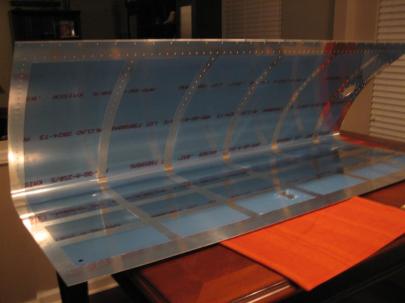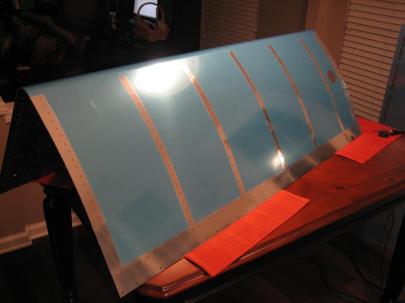Prev | Next
Oh man, I had a great day today.
I’ve been kind of slowly approaching the tanks on my project. I don’t have a lot of apprehension about tank sealant, but I want to close out a few things in other places before I venture too much further.
Nevertheless, I made some big parts (at one point I had a whole wing!), but of course, by the end of the night everything was disassembled. Having the tank assembled allowed me to do most of the prep work I needed to do.
At this point, if I want to, I could go back and finish the leading edge lights on the right leading edge and start actually putting the leading edge together permanently.
Of course, I could always go back and catch the left wing up to the right. But that would be BORING. (I’ll probably keep myself entertained with the leading edge and then go back to the left wing before setting up for tank sealing.
On to the pictures!
First thing, I bolted all of my right z-brackets to the main spar.

The girlfriend was napping, so instead of riveting the inboard nutplates to the spar, I just used some spar An365 nuts.
My best tool today was the 3/8″ power drive socket that came from a gift my girlfriend’s dad gave me.
I can’t imagine having done these by hand. 2 minutes versus 20 minutes, maybe?

I don't have a picture of the whole set, but it is a really nice Dewalt driver set.
Okay, with the z-brakets bolted to the spar, it’s now time to get the baffle in place with the tank skin.

Here's the baffle.
Then, I had an epiphany. A lot of people cleco the skin to the baffle, but then don’t really have a good way to clamp the tank assembly in place to accurately drill the inboard and outboard z-brackets. Some people try to clamp it really well, others will pad the tank assembly and try to use tie-down straps around the whole wing.
I read (and re-read) the instructions, and came across a step that simply says
Drill the spar attachment screw holes and the W-423 screw holes to final size using a #19 drill.
Well, I couldn’t find a reason not to do that now, so I grabbed my recently ordered #19 bits and got to work.

Here it is.
Then, I decided that I should just go ahead and dimple the holes. Can’t find a reason not to.
(Although now that I’m re-reading the manual, I see a statement in there that says to dimple the tank skins using a c-frame and a hammer. Oh well, I think the dimples look good.)

Here's s a dimple for a #8 screw.

And with a AN509-8R8 screw.
After that little test, I went ahead and finished the rest of the spar attach holes.

These should let me really solidify the tank in it's final position for all drilling. No messing around with tie-downs for me!
I cheated a little and didn’t assemble the middle ribs. I figured the two end ribs would be sufficient.

Things are looking big now. This is the top side.

And the bottom side.
Here’s a closeup of the #8 screws helping me align the tank.

This worked great.
There were a few places where things didn’t line up perfectly, but this difference (tank on the left, leading edge skin on the right) is less than 1/64″. I’ve way zoomed in on this next picture. I would call this basically perfect. Some careful edge finishing on the leading edge will line up these seams nicely.
I can’t even figure out how I would improve this if I wanted to, which I don’t.

Lining up pretty good. For reference, that is a 1/8" hole, and I think that step is about 1/10 of the hole. Multiplication tells me it's about 1/80." There's no way any of you will ever notice this on my plane.
Near the leading edge, the gap looks amazing. Remember, this is my macro setting on the camera. Those are all 1/8″ holes.

Great (lack of) gappage.
At the leading edge, I couldn’t figure out why I had a little step here. Again, this is really small, and I’m totally happy with it.

This small step is hardly noticeable.
So other builders will drill the inboard and outboard z-brackets (which requires removing the leading edge) then you have to remove the skin to get to the other z-bracket holes, then you have to re-install both the leading edge and the tank skin to drill the tank-to-leading-edge #19 holes.
Why not do them now? Everything is rock solid and perfectly aligned.

I first matchdrilled the #40 hole into the flange behind the prepunched holes, then I enlarged the hole to #21, then finally #19.
After that was all done, I moved on to the inboard z-bracket. Like everyone else, here’s a picture of me drilling the z-bracket holes.

I had to use the flash here because this side of the tank was in a little big of a shadow. (I bent the bit a little while drilling to make sure the hole was straight.
After drilling and adding a cleco (9 times), I had the inboard side done.

Wuhoo!
Then, I apparently took another picture of the whole wing because I was so excited.

It's so big (TWSS).
Then, I struggled for about 10 minutes trying to really gently pull the leading edge off without disrupting the tank alignment.
Turns out, the joint plate and leading edge inboard rib fit so well, the friction kept me from sliding it out.
I had to remove the inboard rib (and joint plate) from the leading edge to get it to come off.

Of course, Jack and Ginger are playing in the background.
Then, the same drilling drill (ha) on the outboard side of the tank.

One done.

Nine done.
Alright, let’s get the rest of these z-brackets drilled.

After removing the skin, I saw (bracket) metal underneath all of the baffle prepunched holes. That means I didn't reverse any of the brackets.
With my drill stop attached to my #40 bit, I drilled the 25 remaining holes.

It's nice to be at this point, I've been reading about this whole process on everyone else's build sites forever.
After pulling the ribs and baffle back off, I saw holes in all of my z-brackets.

Holes were right where they were supposed to be.
Don’t believe me? Here’s an example.
Notice how the holes are slightly off-center? This was exactly what I was expecting. See the “checkoway method” explanation on my previous post (about 1/3 the way down).

It feels good to see these holes exactly where I thought they would be.
Then, I deburred the holes I just drilled in the right z-brackets.

Z-bracket holes deburred.
That was about 3 hours worth of work. Great day, and the tank alignment was great.
Prev | Next





 Posted by Andrew
Posted by Andrew 

















































































